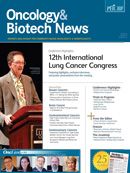Publication
Article
Management of Adult ALL Refined
Author(s):
Outcomes in the treatment of acute lymphoblastic leukemia (ALL) differ in children and adults, with pediatric patients (including adolescents and young adults) having much higher cure rates than adults.

Daniel J. DeAngelo, MD, PhD
Outcomes in the treatment of acute lymphoblastic leukemia (ALL) differ in children and adults, with pediatric patients (including adolescents and young adults) having much higher cure rates than adults. Five-year survival goes down dramatically as people age, whereas it is between 60% and 80% in children up to age 15.
“ALL is not one disease. The distribution of cytogenetic abnormalities differs in children and adults with ALL,” said Daniel J. DeAngelo, MD, PhD, clinical director of the Adult Leukemia section at the Dana-Farber Cancer Institute in Boston, Massachusetts.
In his discussion of the implications of age in treatment selection for ALL, DeAngelo divided the disease according to Philadelphia chromosome-negative (PH—) or PH-positive (PH ).
PH— ALL
Two commonly used regimens for ALL are the CALGB regimen, which is a complicated regimen based on a 5-drug induction with dexamethasone, high-dose cytarabine, and methotrexate, or a somewhat less complicated regimen of HyperCVAD (ara-C plus methotrexate with cyclophosphamide, vincristine, doxorubicin, and dexamethasone).
“Despite 15 years of study of variations of these regimens, we have not made a single impact on outcomes in adults,” DeAngelo said.
Both regimens are superimposable in terms of disease-free survival (DFS) adults with ALL, he continued.
A matched sibling allogeneic transplant is also an option for adults with PH— ALL. In the MRC UKALL XII trial/ECOG E2993 [Goldstone et al. Blood. 2008;111(4):1827-1833], 5-year overall survival was 53% for patients with a donor and 45% for those with no donor. The greatest benefit was observed in standard-risk patients; no benefit was seen in high-risk patients. Highrisk older patients (ie, >35 years of age, high white blood cell counts) had unacceptably high mortality from transplantation.
Using “pediatric-inspired” regimens in young adults is gaining favor as a treatment approach, DeAngelo noted. In patients aged 19 to 30 years, a pediatric protocol achieved improved outcomes in event-free survival (EFS) and overall survival (OS) similar to that in adolescents (aged 15-18 y) [Ribera et al. J Clin Oncol;2008:26(11):1843-1949]. That protocol included a standard 5-drug/5-week induction followed by 2 cycles of early consolidation and maintenance therapy for up to 2 years for those in complete remission.
Other studies have also shown that a pediatric-inspired approach improved EFS and OS, DeAngelo noted. At Dana-Farber, a trial in adults with ALL using a regimen based on a Pediatric Consortium trial achieved a 45-month DFS rate of 66.2%, which is an improvement, he said.
“
The incorporation of imatinib has improved the outcomes in patients of transplant age. ”
—Daniel J. DeAngelo, MD, PhD
PH ALL
PH ALL was historically difficult to treat until the development of imatinib, a tyrosine kinase inhibitor (TKI). “The incorporation of imatinib has improved the outcomes in patients of transplant age,” DeAngelo said.
Allogeneic stem cell transplant is standard treatment for patients in complete remission. Studies have shown that the use of imatinib improves outcomes in PH ALL patients who undergo allogeneic transplant.
A newer-generation TKI, dasatinib, may make it possible to avoid transplant in newly diagnosed PH ALL, DeAngelo said. A recent study included 35 newly diagnosed PH patients who were treated with dasatinib on the first 14 days of 8 cycles of alternating HyperCVAD and high-dose cytarabine plus methotrexate [Ravandi et al. Blood. 2010;116(12):2070-2077]. Complete remission (CR) was 94%. Patients in CR received maintenance therapy with daily dasatinib and monthly vincristine and prednisone for 2 years followed by dasatinib.
Future areas of study include new approaches to T-cell ALL, BiTE-specific antibodies to treat minimal residual disease in ALL, and use of JAK2 or HSP90 inhibitors in JAK2-positive ALL.










